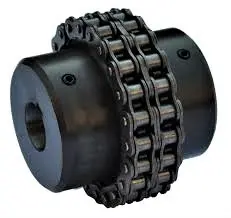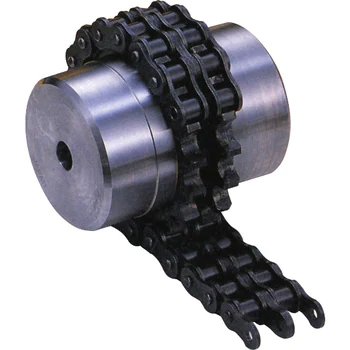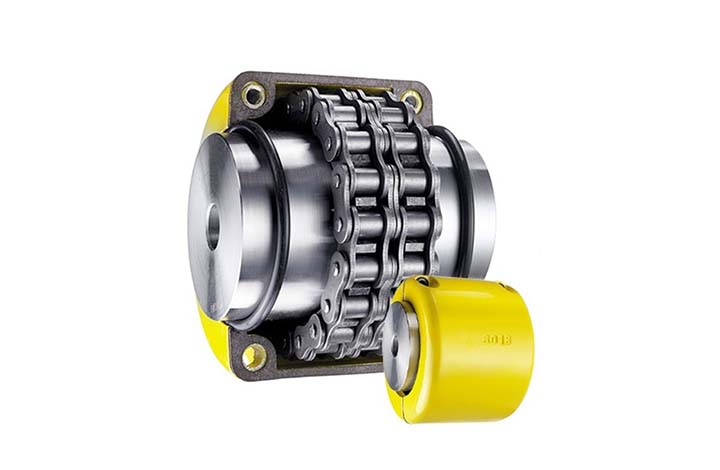Product Description
Roller chain coupling 12018
Our Roller Chain Coupling details:
Size: 3012, 4012, 4014, 4016, 5014, 5016, 5018, 6018, 6571, 6571, 8018, 8571, 8571, 10018, 10571, 12018, 12571
Our Roller Chain Coupling Specification:
1. Material: C45 steel, Alloy steel, Aluminum, Rubber and plastic etc.
2. OEM and ODM are available
3. High efficient in transmission
4. Finishing: Painted.
5. High quality with competitive price
6. Different models suitable for your different demands
7. Stock for different bore size on both sides available.
8. Application in wide range of environment.
9. Quick and easy mounting and disassembly.
10. Resistant to oil and electrical insulation.
11. Identical clockwise and anticlockwise rotational characteristics.
12. Small dimension, low weight, high transmitted torque.
13. It has good performance on compensating the misalignment.
Chain Coupling Application:
Chain couplings are offered in the industry’s largest variety of stock bore/keyway combinations. These couplings require no lubrication and provide highly reliable service for light, medium, and heavy duty electrical motor and internal combustion power transmission applications. Applications include power transmission to industrial equipment such as pumps, gear boxes, compressors, blowers, mixers, and conveyors.
/* March 10, 2571 17:59:20 */!function(){function s(e,r){var a,o={};try{e&&e.split(“,”).forEach(function(e,t){e&&(a=e.match(/(.*?):(.*)$/))&&1

Real-World Examples of Successful Roller Chain Coupling Installations and Benefits
1. Industrial Conveyor Systems:
Roller chain couplings are widely used in industrial conveyor systems to transmit power between the driving and driven shafts. They provide reliable torque transmission and can accommodate misalignments, ensuring smooth and efficient operation of the conveyor. The benefits include reduced downtime due to their robustness and the ability to handle heavy loads in demanding environments.
2. Heavy Machinery Applications:
In heavy machinery such as mining equipment, steel mills, and large cranes, roller chain couplings play a crucial role in transmitting power from the motor to various mechanical components. The ability to withstand high torque and shock loads ensures the safe and efficient operation of these machines. Roller chain couplings’ durability reduces maintenance requirements and enhances overall system reliability.
3. Pumping Systems:
Roller chain couplings are used in pumping systems for various industries, including water treatment, oil and gas, and chemical processing. They offer the advantage of absorbing vibration and shock loads, contributing to the smooth and continuous operation of pumps. Their flexibility allows them to compensate for any misalignment between the motor and pump shafts, reducing stress on the equipment and increasing its lifespan.
4. Paper and Pulp Industry:
In the paper and pulp industry, roller chain couplings are employed in various applications, including paper machines and pulp processing equipment. Their ability to handle high-speed and high-torque requirements makes them suitable for demanding tasks. Roller chain couplings contribute to reduced maintenance costs and improved productivity by ensuring efficient power transmission in critical processes.
5. Automotive Manufacturing:
Automotive manufacturing plants use roller chain couplings in assembly line machinery and robotic systems. The couplings help in providing precise power transmission, ensuring accurate and synchronized movement of equipment. This results in improved production efficiency and reduced downtime, leading to cost savings and enhanced manufacturing output.
Overall, roller chain couplings have demonstrated their effectiveness and versatility across various industries. Their ability to handle misalignments, shock loads, and high torque makes them an excellent choice for demanding applications where reliability and efficiency are critical.
“`
Maintenance Requirements for Roller Chain Couplings
To ensure the optimal performance and longevity of roller chain couplings, regular maintenance is essential. Here are some key maintenance requirements:
- Lubrication: Regularly lubricate the roller chain and sprockets to reduce friction and wear. Use the appropriate lubricant recommended by the coupling manufacturer.
- Inspections: Periodically inspect the coupling for signs of wear, misalignment, or damage. Look for elongation or wear of the roller chain, damaged sprocket teeth, or any signs of excessive vibration.
- Tightening: Check and ensure that all fasteners, such as bolts and set screws, are properly tightened to the manufacturer’s recommended torque specifications.
- Alignment: Maintain proper alignment between the driving and driven shafts to prevent undue stress on the coupling components.
- Cleanliness: Keep the coupling and surrounding area clean and free from debris or contaminants that could interfere with its operation.
- Temperature: Avoid operating the coupling beyond its recommended temperature limits, as excessive heat can lead to premature failure.
- Replacement: Replace any worn or damaged components promptly to prevent further damage to the coupling or connected equipment.
Regular maintenance not only ensures the coupling’s optimal performance but also helps identify potential issues early, allowing for timely repairs or replacements. It is crucial to follow the manufacturer’s maintenance guidelines and schedule to ensure the coupling’s reliability and prevent unexpected failures that could disrupt operations and lead to costly downtime.

What is a Roller Chain Coupling and How Does It Function in Mechanical Power Transmission?
A roller chain coupling is a type of flexible coupling used in mechanical power transmission systems to connect two shafts and transmit torque between them. It consists of two sprockets, one on each shaft, and a roller chain that meshes with the sprockets.
The functioning of a roller chain coupling is as follows:
- Connection: The roller chain coupling is installed by placing the two sprockets on the respective shafts. The sprockets are positioned facing each other.
- Meshing: The roller chain is then looped around the sprockets, and its pins engage with the teeth of the sprockets.
- Power Transmission: When one shaft rotates, the roller chain transfers the rotational motion to the other shaft through the meshing of the chain with the sprockets.
- Torque Transfer: The torque is transmitted from one shaft to the other via the roller chain. This allows the two shafts to rotate together, providing a flexible and efficient power transmission connection.
Roller chain couplings are known for their reliability, simplicity, and ability to handle high torque loads. They are widely used in various industrial applications, including conveyor systems, pumps, mixers, and other equipment that require reliable torque transmission.


editor by CX 2024-02-23